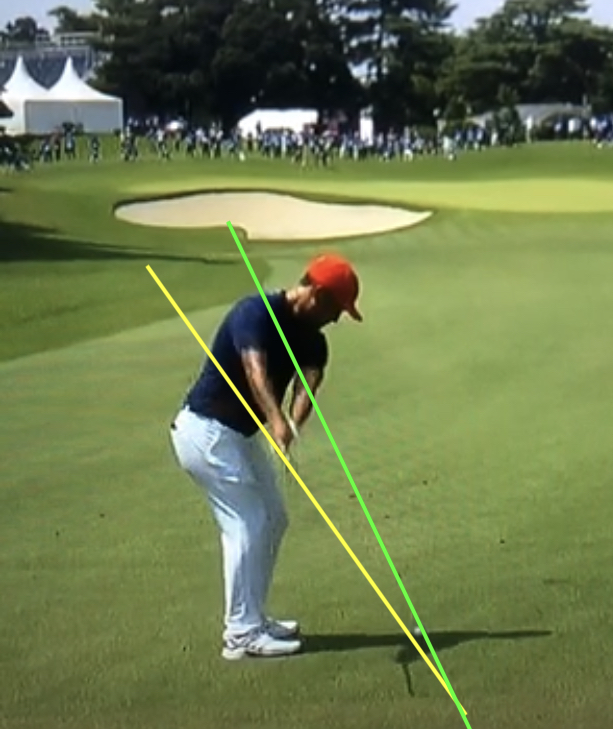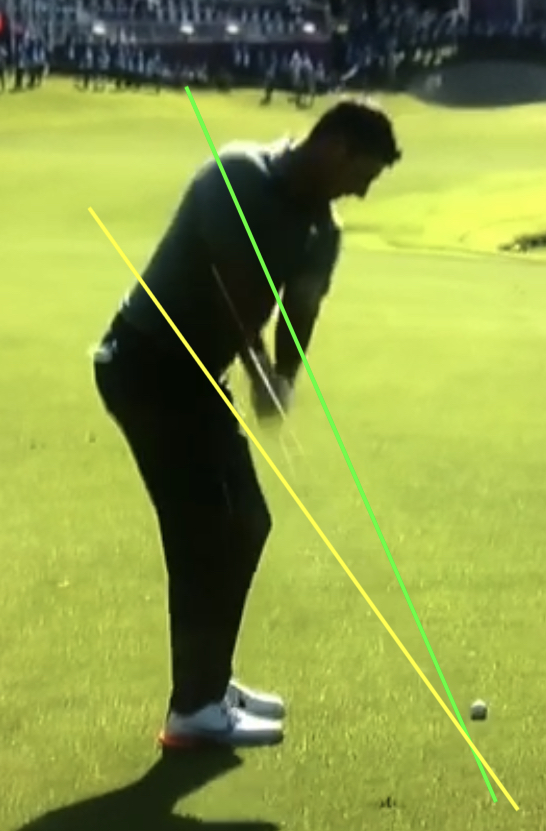Those who often get caught with a distance wedge
If your tee shot is a good shot and you are aiming for par with about 100 yards to go, you may find yourself in a situation where you hook a shot and end up in a side bunker, not even getting out of the bunker in one shot.
It is important to correct the distance wedge hooking shots around 100 yards or so, as it can be a major factor in ruining your score.
The mechanism behind the big hooks is
- Club head trajectory is too far in from the inside
- Face closed at impact
This is caused by two factors.f
The reason for these two factors varies from person to person, but first, take a picture of your swing plane and hand position from behind with a smartphone or similar device.
Then, use a smartphone app to draw a line like this.
I recommend an smartphone app called “Kizuki”, which is the most simple and free.
Using the “Kizuki”, draw a line on the shaft and a line connecting the neck of the shaft to the elbow of the arm.
The first thing to check is the take back.
The position where the club shaft is parallel to the ground (P2 position)
This is the P2 position.
For starters, the P2 position of PGA Tour pros looks like these.


The position of the hands should be traced up the shaft plane (yellow line).
The position of the hands here is important, but many amateurs with a lot of hooking tend to have their hands off the plane and up to the green line.
There are almost no PGA Tour pros whose hands are up to the green line in P2.
If your hands are up to the top line, gravity will cause the club head to drop and the club head will have too sweeping of a trajectory, making it easier to go inside.
If you have this habit, you need to fix it or your distance wedge will never be stable.
I don’t have a good video on how to fix this.
- Prepare a ball of an appropriate size (a soccer lifting ball is the best size). You may or may not have a club.
- In the video, you can see that the ball is not held between the arms, but between the elbows and the dove tail to prevent it from falling.
- Keep the ball pressed against your dove tail with your elbow, and take back to the P2 position (shaft parallel to the ground) with your hands as close to your body as possible.
Repeat this kind of practice about 30 times daily at home so that you can reproduce it on the practice range.
It will feel very strange at first, and you won’t be able to visualize hitting the ball at all.
Also, if you keep your hands on your body, you may end up pulling the club too far to the inside.
However, don’t worry if you pull the club too far to the inside at first.
First, focus on fixing the P2 hand position.
Once the P2 hand position is fixed, the hand position at the top will naturally be closer to the plane, and the hands will not move forward on the downswing, which should reduce the number of errors.
Once the P2 hand position is fixed, correct the position of the club.
If you have been pulling the club head too far to the inside, try practicing with your hands close to your body and the club parallel to the ball.
This will bring your hands and club on plane and improve the accuracy of your shots.
First, correct the position of your hands, then the club head, in that order.
If you continue to practice ball-hugging for about three months, you will not be able to swing with your hands in the wrong direction.


Comments